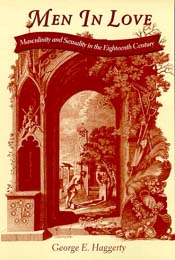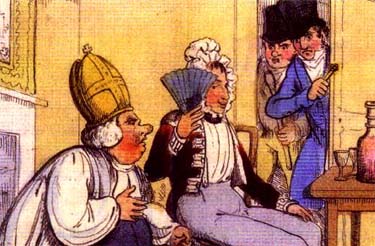 |
|
in the Eighteenth Century Courtesy of the International Gay and Lesbian Review. One Institute Press Men in Love: Masculinity & Sexuality in the Eighteenth Century, by George E. Haggerty, Columbia University Press, 1999, 214 pages, illustrations, bibliography. Paperback ISBN: 023111043X. Hardback ISBN 0231110421  Abstract:
Abstract: George E. Haggerty explores the complicated issue of male-male desire in the late seventeenth and eighteenth century. Focusing on a range of identities, he asks how we might perceive the expression of desire as moving beyond a physical definition into the realm of love. He provides an examination of the continuum of friendship and love between men, through examining the letters, diaries and fiction of important literary men. Beginning with heroic friendships in Dryden and Lee's tragedies, he then studies fops and beaus in Restoration comedy. He then devotes a chapter each to the complicated personal lives of the poet Thomas Gray, and the writers Horace Walpole and William Beckford. Men in Love is essential reading for anyone interested in understanding the contours of homoerotic desire in the period. Review Men in Love: Masculinity and Sexuality in the Eighteenth Century offers to appropriate the concept of love in the problematic discussion of 'homosexuality' in the late seventeenth and eighteenth century.
In part one, representations of masculinity and the homosocial are traced sensitively through successive literary genres in the eighteenth century. Chapter one on Restoration drama examines plays such as Nathaniel Lee's The Rival Queens and John Dryden's All for Love. In All for Love, the erotic dimensions of the heroic friendship of Anthony and Dolabella are shown to reinforce Roman male power. Haggerty is interested in the seeming 'normativity' of such heroic friendships which problematize a hetero/homo dichotomy of sexuality. This argument is developed in the following chapter focusing on the subtle transformation in the status of the fop from being coded in Restoration drama with libertine excess and monstrosity, and then moving to a sexually suspect position. The inclusion of portraits by various eighteenth century artists illustrates how the difference between 'straight' and 'gay' fops resided in bodily posturing, although this could have been explored with more paintings. The evolution of the fop into being associated with sodomitical identities is explored through Tobias Smollett's novels where foppishness becomes an index of male sexual transgression and is subject to ridicule.

The chapters devoted to Thomas Gray, Horace Walpole and William Beckford explore the difficulty of approaching sexually ambiguous figures with an essentialist viewpoint of sexuality. In the case of Gray, the reclamation of love to describe how homoerotic desire is given form and substance in Gray's poetry and letters works particularly well. He argues that Gray's desire is inscribed through the poetics ofSensibility, particularly the themes of absence, loss and death, and thus his desire is indistinguishable from the prevailing culture in which he writes. Haggerty also quotes in full a relatively unfamiliar Latin elegy of 1742 appended to Gray's De Principiis Cogitandi which indicates how the opportunity to mourn for Richard West allows for desire to be expressed covertly. This is encapsulated in an observation which is repeated twice in the space of four pages, 'Every line reveals as much as it conceals, and poetry itself, decorous and allusive, becomes the vehicule for private longing' (p.122). His argument that Walpole intentionally created 'the mystery of privacy' in his letters to Lord Lincoln and his cousin Henry Seymour Conway to divert attention away from any erotic component to these relationships appears odd. One might justify this argument by presuming that Walpole may have feared blackmail, a subject which is overlooked here. The rumours and gossip surrounding Beckford's attachment to the young Viscount William Courtenay are perceived as another variation in the types of masculinities emerging in the public consciousness of the eighteenth century. Paederasty becomes available as a concept by which to define male sexuality, and Haggerty usefully explores the historical lines of continuity and discontinuity with sodomy in defining this term. Although the local readings of Beckford's correspondence to his Venetian confidante, the Contessa D'Orsini-Rosenberg are penetrative and illuminating, Haggerty does not explore the importance of class as much as he promises to do at the outset of the book. Nevertheless, this is a well written study of how the shapes of male sexuality, both privately and in fiction, evolved in relation to social perceptions of same-sex acts and masculinity over the course of the century. Max Fincher is a research student based at King's College, University of London. He has recently submitted a Ph.D. thesis on queer readings of Gothic fiction written by men in the late eighteenth and early nineteenth century. Currently he is working on a screenplay adaptation of a popular Gothic novel, and hoping to find more teaching opportunities. He lives in Aylesbury in Buckinghamshire. |

